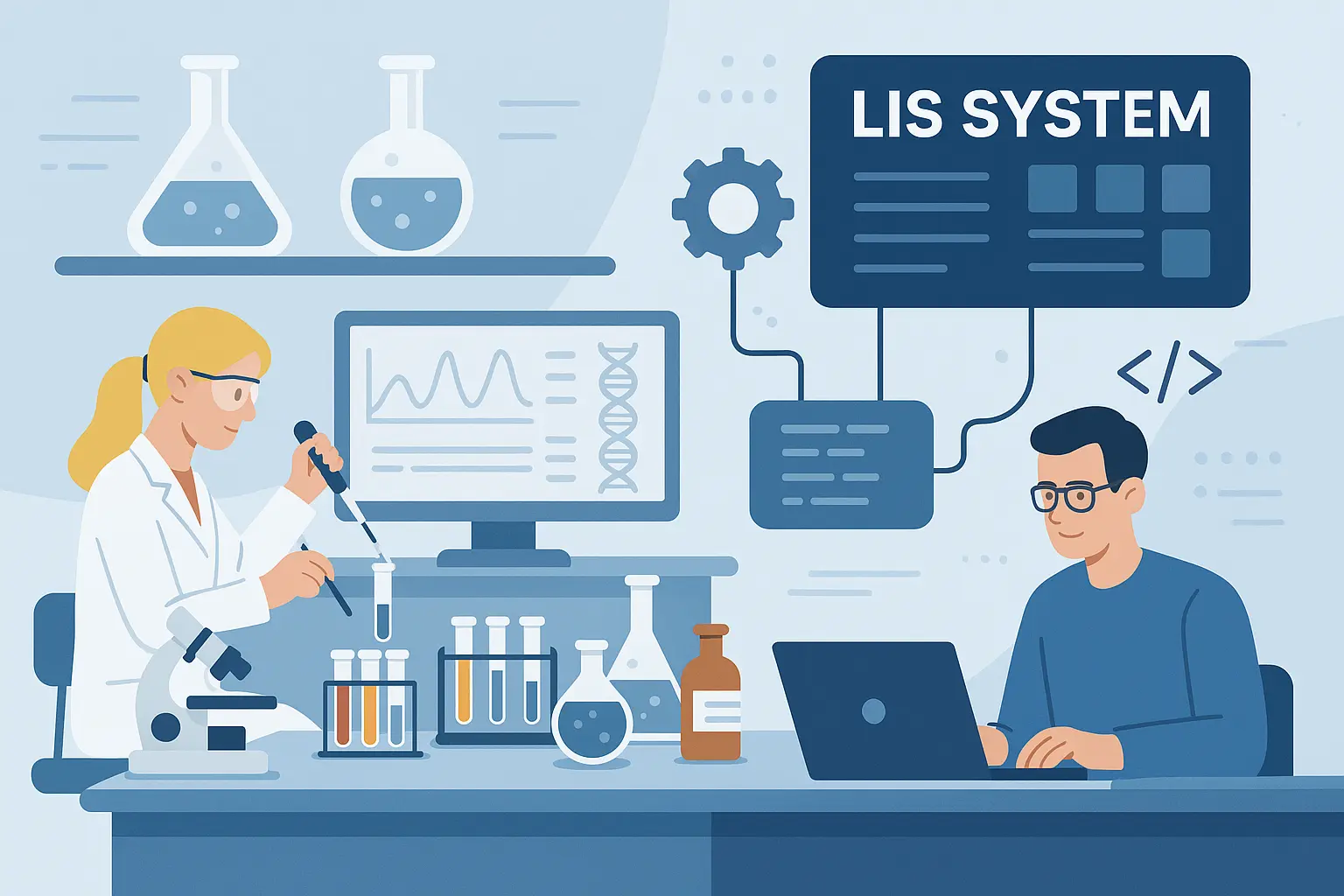Blog
Keys to Keeping Your LIS System Implementation on Track
December 19, 2024
Congratulations!
Thanks to your exceptional communication, leadership, and planning skills, lab ownership has picked you to lead the biggest project the clinical lab or pathology group has undertaken so far…implementing a new laboratory information system (LIS system).
To be expected, you’re both excited and terrified at the thought of managing such an enormous and mission-critical project. After giving yourself a few minutes to get composed, you do what you always do: roll up your sleeves and get to work.
Yes, it’s a massive project, that’s clear. It will require extensive planning, well-thought-out objectives, efficient resource management, and team buy-in and support. But you’re not alone. Others have been in your shoes, successfully managed such a difficult project as this, and come out on the other end as a lab hero.
We know you’re up for the challenge, and we’re here to help keep the LIS system implementation on track with a high-level project management checklist to guide you from start to finish.

Let’s Get Started
So you’ve been picked to lead the project. Now what? What are the initial first steps to take?
Whether your lab is installing its first lab information system, converting to a new medical LIS, or upgrading from a legacy LIS software, the first step should be to form a committee.
Learn More: How to Set Up a Committee to Select a Laboratory Information System
Next, and just as important, is conducting a needs assessment. This entails evaluating current laboratory processes to identify strengths, weaknesses, and areas that need improvement. After completing this internal assessment you and the team will truly understand the specific requirements the new laboratory information system will need to support.
The next order of business is selecting the best LIS system for your lab’s current needs and future goals. This will require thorough market research to identify a shortlist of laboratory information system companies before engaging them for more information and LIS software demonstrations.
A Request for Proposal (RFP) is a widely accepted way to engage with potential laboratory information system vendors, introduce them to your lab, and solicit their proposals based on your lab’s specific requirements. The submitted RFPs will help you and your colleagues uniformly compare various LIS systems (click to see an example RFP template).
Attending trade shows, reading journals, and gathering input from other laboratories are additional recommended steps while conducting market research.
Learn More: What You Need to Know Before Contracting with a Laboratory Information System (LIS) Company
Understand that successful laboratory information system software implementations begin with the analysis and selection stages so don’t rush either process. Take the time to clearly outline the goals, the scope, and the expected outcomes. Also, discuss responsibilities, deliverables, and schedules with the LIS company you ultimately choose to partner with and establish early on your lab’s configuration and customization specifications.

Planning for LIS System Success
Establishing your LIS system selection committee is a big first step, and so is recognizing and avoiding the common pitfalls tied to such a large project.
The pitfalls to avoid include:
- Insufficient or deficient planning
- Lack of project management
- Over-reliance on the LIS software vendor’s skills and resources
- Ineffective management of staff resources and change processes
- An overestimation of project resources
- Scope creep
There’s no such thing as over-planning, so take the time to do it right. You’ll be glad you did.
Be mindful of the difference between managing the project and allowing it to manage you. Take a proactive rather than reactive approach, anticipate risks, and set clear goals and milestones based on confirmed resources.
Also, this isn’t the lab vendor’s installation, rather it’s your lab’s implementation. This subtle change in mindset will go a long way in ensuring that your team and the LIS company are together leading the direction and pace of the project.
Basic Laboratory Information System Project Plan Template
Creating a basic LIS laboratory information system project plan involves several key steps that must be taken to ensure that all aspects from initial assessment to go-live and post-implementation support are thoroughly addressed.
Here is a basic project plan outline. Think of it as a starter template you and your team can use as a guide while adding specific details and considerations as the project progresses.
1. Project Initiation
- Objective: Establish the project's goals, scope, and constraints.
- Key Activities:some text
- Define project objectives and scope.
- Identify project stakeholders.
- Formulate the project team.
- Develop project outline and secure approval.
2. Requirements Gathering
- Objective: Capture detailed functional and non-functional requirements.
- Key Activities:some text
- Conduct interviews and workshops with stakeholders including lab technicians, IT staff, and management.
- Document existing lab workflow to understand current processes and pain points.
- Prepare a detailed requirements specification document.
- Validate and get approval for the requirements from all stakeholders.
3. Laboratory Information System Selection
- Objective: Choose the best LIS system based on the gathered requirements.
- Key Activities:some text
- Research and evaluate potential LIS software vendors and LIS systems.
- Send out Request for Proposals (RFPs) and evaluate responses.
- Conduct LIS system software demos, and review LIS company presentations.
- Select the LIS system and negotiate contract terms.
4. Project Planning
- Objective: Plan the detailed execution of the lab information system implementation.
- Key Activities:some text
- Develop a comprehensive project plan including timelines, resources, budget, and risk management plans.
- Establish communication plans.
- Define project milestones and critical paths.
- Set up project management tools and dashboards for tracking progress.
5. LIS System Design and Customization
- Objective: Customize the laboratory information system implementation to fit the specific needs of your laboratory.
- Key Activities:some text
- Work with the LIS company to design lab information system configurations that meet the lab’s requirements.
- Map and re-engineer lab workflow to optimize processes.
- Customize LIS system interfaces and reporting templates.
- Ensure compliance with relevant regulations and standards.
6. Interface Development and Integration
- Objective: Develop and integrate all necessary interfaces between the lab information system and other laboratory software systems.
- Key Activities:some text
- Work with lab vendors to develop an Electronic Health Record (EHR) interface with the LIS system to exchange orders, results, and patient demographics. Use HL7 or other relevant protocols for data exchange.
- If the plan is to use separate systems for pathology LIS and lab RCM workflow, develop an interface to transmit laboratory billing data, including CPT codes, patient information, and charges between the two systems.
- Interface each laboratory instrument with the LIS system to automate test orders and results capture. Use ASTM, HL7, or other relevant protocols for data exchange.
- Conduct end-to-end testing of each interface to ensure proper communication and data integrity.
- Document interface specifications and make sure they align with the LIS software vendor's capabilities.
7. Data Migration Planning and Execution
- Objective: Ensure a seamless data transition from legacy systems to the new laboratory information system.
- Key Activities:some text
- Conduct a thorough analysis of existing data that needs to be migrated to the new LIS lab system (e.g., patient records, test results, historical data).
- Create a data mapping document that aligns the old system's data fields with the new laboratory information system.
- Clean and validate the existing data to remove duplicates and ensure data accuracy.
- Extract, transform, and load (ETL) data from the legacy system(s) into the new LIS system.
- Validate data migration by performing checks to ensure data integrity, completeness, and accuracy.
8. LIS System Implementation
- Objective: Install and configure the LIS system software in the laboratory environment.
- Key Activities:some text
- Set up hardware and network infrastructure.
- Install the LIS system and conduct initial configurations.
- Integrate the medical LIS with existing laboratory software systems (e.g., EHR, laboratory billing software).
- Data migration from old systems to the new medical LIS.
9. Testing and Validation
- Objective: Ensure the lab information system meets all specifications and requirements.
- Key Activities:some text
- Conduct unit, integration, and LIS system testing.
- Perform user acceptance testing (UAT) with real user scenarios.
- Validate the laboratory information system for regulatory compliance.
- Resolve any issues and retest as needed.
10. Training and Change Management
- Objective: Prepare the end-users to transition to the new laboratory information system.
- Key Activities:some text
- Develop and deliver training programs tailored to various user groups.
- Provide documentation and support materials.
- Implement change management strategies to ease the transition.
- Set up a support structure with the LIS company for post-go-live issues.
11. Go-Live
- Objective: Successfully deploy the LIS system software for operational use.
- Key Activities:some text
- Plan and execute the go-live strategy.
- Provide intensive support during the initial days of go-live.
- Monitor lab information system performance and user feedback.
- Make immediate adjustments as necessary.
12. Post-Implementation Review and Support
- Objective: Ensure ongoing success and optimization of the newly implemented medical LIS.
- Key Activities:some text
- Conduct post-implementation reviews to capture lessons learned.
- Provide ongoing support and troubleshooting.
- Plan for periodic updates and maintenance.
- Evaluate LIS system performance and user satisfaction continuously.
This basic project plan provides a structured approach to successfully planning and launching laboratory information system software. FYI, the LIS company you contract with may also have a project plan (see LigoLab’s project plan template here).
Although projects of this size and complexity rarely go according to plan from start to finish, these template examples will help you and your team get started and create the necessary momentum to keep your project on track even when unforeseen challenges inevitably surface.

What is a Successful LIS System Implementation?
So how does one judge success? Consider whether or not objectives were met, satisfaction was achieved, and whether success is sustainable over time.
Has the laboratory information system implementation satisfied customers?
- Does the LIS system maintain or improve quality?
- Has it improved laboratory responsiveness?
Has the LIS system implementation satisfied users?
- Has the medical LIS made their jobs easier to perform?
- Are their jobs more gratifying?
Has the LIS system implementation satisfied lab management?
- Has the LIS system reduced risk?
- Has it raised efficiency and reduced unit costs?
- Is it augmenting decision-making?
Can the lab information system support sustained success?
- Can the LIS system adapt to changing customer demands?
- Adapt to changing user needs?
- Adapt to a changing environment?
- Maintain risk avoidance?
- Maintain cost savings?
Successfully implementing a laboratory information system is a great challenge and its importance cannot be understated. It requires leadership, buy-in from ownership/management and all other stakeholders, real resources, realistic expectations, and an all-hands-on-deck attitude.
Despite the difficulties, it can be done and those that make it happen are the true winners.






